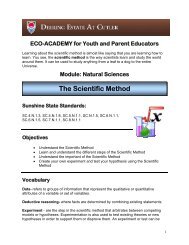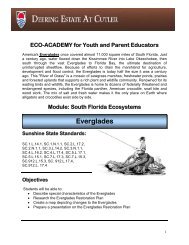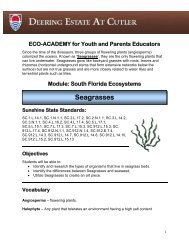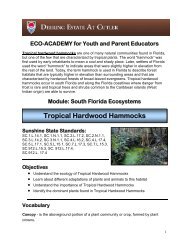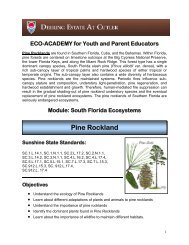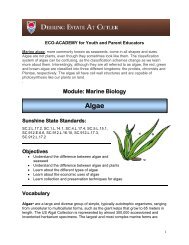Salt Marshes Lesson Plan - Deering Estate at Cutler
Salt Marshes Lesson Plan - Deering Estate at Cutler
Salt Marshes Lesson Plan - Deering Estate at Cutler
Create successful ePaper yourself
Turn your PDF publications into a flip-book with our unique Google optimized e-Paper software.
Coast- is defined as where the land meets the sea. A precise line th<strong>at</strong> can be called a<br />
coastline cannot be determined due to the dynamic n<strong>at</strong>ure of tides. The term "coastal<br />
zone" can be used instead, which is a sp<strong>at</strong>ial zone where interaction of the sea and<br />
land processes occurs<br />
Halophyte- is a plant th<strong>at</strong> n<strong>at</strong>urally grows where it is affected by salinity in the root area<br />
or by salt spray, such as in saline semi-deserts, mangrove swamps, marshes and<br />
sloughs, and seashores.<br />
Intertidal zone- (also known as the foreshore and seashore and sometimes referred to<br />
as the littoral zone) is the area th<strong>at</strong> is exposed to the air <strong>at</strong> low tide and underw<strong>at</strong>er <strong>at</strong><br />
high tide (for example, the area between tide marks).<br />
Marsh - is a type of wetland th<strong>at</strong> is subject to frequent or continuous flood. Typically the<br />
w<strong>at</strong>er is shallow and fe<strong>at</strong>ures grasses, rushes, reeds, typhas, sedges, and other<br />
herbaceous plants. Woody plants will be low-growing shrubs. A marsh is different from<br />
a swamp, which has a gre<strong>at</strong>er proportion of open w<strong>at</strong>er surface and may be deeper<br />
than a marsh. In North America, the term "swamp" is used for wetland domin<strong>at</strong>ed by<br />
trees r<strong>at</strong>her than grasses and low herbs.<br />
Background<br />
A salt marsh is an<br />
environment in the upper<br />
coastal intertidal zone<br />
between land and salty or<br />
brackish w<strong>at</strong>er, domin<strong>at</strong>ed<br />
by dense stands of<br />
halophytic (salt-tolerant)<br />
plants such as herbs,<br />
grasses, or low shrubs.<br />
These plants are terrestrial<br />
in origin and are essential to<br />
the stability of the salt marsh<br />
in trapping and binding<br />
sediments. <strong>Salt</strong> marshes<br />
play a large role in the aqu<strong>at</strong>ic food web and the exporting of nutrients to coastal w<strong>at</strong>ers.<br />
They also provide support to terrestrial animals such as migr<strong>at</strong>ing birds as well as<br />
providing coastal protection.





